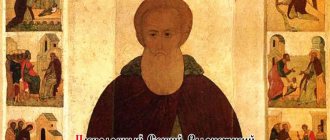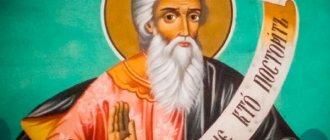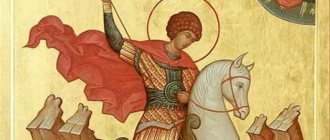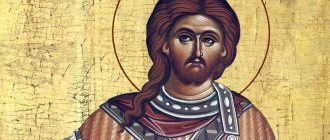Lives of the Martyrs Sergius and Bacchus
Sergius and Bacchus were soldiers in the Roman army. The king greatly respected the martyrs for their courage, loyalty and wisdom. Emperor Maximian did not know that they were Christians and gave them high military ranks. But soon the emperor was informed that Sergius and Bacchus did not worship pagan gods, which in those days was a state crime.
To make sure whether it was true that they were Christians, Maximian ordered Sergius and Bacchus to make a sacrifice in the temple of Zeus, but they refused even to enter the temple, answering that they worshiped only the One God. Then the emperor forced them to enter the temple and insisted that they worship the idols and make sacrifices. But they again disobeyed him and began to accuse the king of his powerlessness before the Lord.
The emperor was angry and ordered to remove the military ranks from the martyrs, dress them in women's clothes and parade them through the city, putting iron hoops around their necks so that the people would laugh at them. After this, they were brought to Maximian and he tried in a friendly way to return them to the pagan faith. However, the saints were unshakable in their faith. Then the governor ordered them to be sent to the eastern part of Syria to Antiochus, who hated Christians. The emperor hoped that Sergius and Bacchus would be frightened by the cruelty of Antiochus and, out of fear, would renounce Christ.
The martyrs were put in chains and taken away from Rome. After a day of travel, the guards accompanying them stopped at a hotel for the night. At midnight, when the soldiers fell asleep, Sergius and Bacchus began to fervently pray that the Lord would give them the strength to courageously endure severe suffering.
During prayer, an Angel of God appeared to them and said that with their steadfast faith they would defeat the devil. Sergius and Bacchus rejoiced and began to pray, praising God. The entire rest of the way, the martyrs prayed and sang psalms, which further strengthened them in their faith.
Recommendations
- January 30, 2011
- ^ a b c d f f gram h Woods
, David (2000). "The origins of the SS cult. Sergius and Bacchus." From Military Martyrs. Retrieved June 25, 2009. - Pio Franchi de Cavalieri, Scritti Agiografici
, Volume I (1893-1900) - Christopher Walter, Warrior Saints in Byzantine Art and Tradition
(Routledge, 2003), pp. 149–150. - "Sergius and Bacchus". From The Catholic Encyclopedia
. Retrieved June 16, 2014. - Boswell, page 155
- Martyrology Romanum
, Libreria Editrice Vaticana, 2001, p. 528. - Free, John (2000). Blue Guide Istanbul
. W. W. Norton & Company. paragraph 137. ISBN 0-393-32014-6. - Boswell, page 146. “By far the most influential group of paired saints were Sergius and Bacchus.”
- Boswell, page 195. “The archetypes mentioned, such as Peter and Paul or Serge and Bacchus, were not in fact brothers, either biologically or legally. It may be questioned whether Peter and Paul were in any sense a couple, but Serge and Bacchus, the most frequently cited archetypes, were certainly influenced by the same cultural bias that created a couple from a single Saint Theodore, it is easy to imagine that Peter and Paul were linked in the popular imagination."
- ^ a b
Boswell, p. 154. - Young, Robin Darling (November 1994). "Gay Marriage: Rethinking Church History." First things
.
47
: 43–48. Retrieved June 25, 2009. - Shaw, Brent (July 1994). “Your own groom?” New Republic
: 43–48. Archived from the original on May 7, 2006. Retrieved June 25, 2009. - Christopher Walter, review of Elizabeth Key-Fowden, The Barbarian Plain: St. Sergius between Rome and Iran
in
Revue des études byzantines
,
59-60
:p. 279 - Albrecht Klasset, Marilyn Sandage, Friendship in the Middle Ages and Early Modernity
, para. 209 - Fowden, Elizabeth Key (1999). Barbarian Plain: St. Sergius between Rome and Iran
. University of California Press. clause 9 and note. ISBN 0520216857. - Jordan, Mark D. (2005). The Blessing of Same-Sex Unions: The Dangers of Queer Romances and the Fallacies of Christian Marriage
. University of Chicago Press. paragraph 134. ISBN 0-226-41033-1. - Jordan, Mark D. (2005). The Blessing of Same-Sex Unions: The Dangers of Queer Romances and the Fallacies of Christian Marriage
. University of Chicago Press. pp.135–136. ISBN 0-226-41033-1. - Jestis, Phyllis G. (2004). Holy Men of the World: An Intercultural Encyclopedia, Volume 3
. ABC-CLIO. item 781. ISBN 1-57607-355-6. - O'Neill, Dennis (2010). Passionate Holiness: Marginal Christian Devotions to Distinctive Peoples
.
Trafford Publishing. paragraph 82 g
. ISBN 978-1426925054.
Where are the relics of saints located?
Antiochus once became a ruler thanks to Sergius and Bacchus and did not want to subject them to torture. The holy martyrs replied that there was no life for them without Christ, and if they died for him, then this would be gain. Antiochus became angry and ordered Bacchus to be beaten with whips. They beat him until he died. They ordered the body of the martyr to be thrown out to be devoured by wild beasts. But Christians secretly took the saint's body and hid it in caves.
Sergius was put on his feet with iron boots, which were filled with nails, and taken to a neighboring city for trial, where he was sentenced to death and his head was cut off with a sword. This happened around 300. Christians buried his body in the same place.
After the execution, every year on the day of the death of the martyr, animals came out of the surrounding deserts and gathered at the place where he was buried. They walked around the holy place and returned to the desert.
A temple was built on the site where the martyr Sergius was beheaded. Now the relics of the martyrs rest in the Church of St. Peter in Venice.
To the catacombs
On the left is priest Sergius Mechev with Metropolitan Macarius (Nevsky) in the Nikolo-Ugreshsky Monastery, 1924. On the right is Sergius Mechev during confession, late 1920s.
Photo: wikipedia.org On December 13, 1931, by decree of the Synod, the entire clergy of the Maroseya church was excommunicated from the Orthodox Church, and the clergy were prohibited from serving in the priesthood. The reason was the public refusal of Father Sergius to carry out the decree of the Patriarchate No. 549 of October 8/21, 1927 on commemorating the authorities during divine services.
Father Sergius was never an ardent anti-Soviet. He even managed to serve in the Red Army and work in Soviet institutions. “My husband has always accepted Soviet power,” his wife Evfrosinia Nikolaevna confirmed, according to the investigation reports.
At the same time, he was unable to accept the notorious “Declaration” of Metropolitan Sergius (Stragorodsky), published in the newspaper Izvestia in August 1927. In it, the then official church leadership (Sergius, Deputy Patriarchal Locum Tenens, Metropolitan of Nizhny Novgorod, and the Provisional Patriarchal Holy Synod) reported that the Patriarchate was “decisively and irrevocably taking the path of loyalty” and expressed gratitude to the Soviet government “for attention to the spiritual needs of the Orthodox population.” Mechev could not agree with these words. “Churches both in Moscow and in the provinces were closed, everything fell into disrepair. And Metropolitan Sergius, arguing the opposite, acted to please the Soviet government, with his authority as the leader of the Church he covered up the policy of oppression of the Church pursued by the Soviet government,” recalled Father Sergius Mechev. “I separated from him, locked myself in my church, and did not carry out those orders of his that contradicted the church charter and my conscience.”
Father Sergius tried for almost two years to decide his attitude to what was happening. While many priests in his circle decisively broke with Metropolitan Sergius and stopped commemorating him during services, Priest Sergius Mechev sought a compromise. He continued to commemorate Metropolitan Sergius on the solea, outside the altar, stopping the commemoration only in the altar.
“He tried to make us understand him, but did not force anyone to follow him,” recalled parishioner of the Klennikovsky church Elena Apushkina. “If you do not share my path, go yours, but I cannot go any other way,” he said. His soul did not accept what seemed to him to be contrary to his views on the essence of the Church; he referred to his “weak conscience.”
Alas, this line of behavior only brought confusion into the life of the parish. Many parishioners began to accuse Father Sergius of duplicity, and some even left the community. Apparently, this prompted the rector to make a decision: he refused to obey Metropolitan Sergius and pray for the godless government, explaining to the parishioners that “you can only pray for the believing government.”
The result followed immediately: on October 29, 1929, Father Sergius, along with two priests and nine parishioners, was arrested, accused of “anti-Soviet activities” and exiled for three years “to the Northern Territory.”
He never returned home. The remaining twelve years of life consisted of alternating prisons, camps, exile, and rented apartments. I saw my wife and four children sporadically. All the priests of the Klennikovsky church and many of the parishioners of Father Sergius were arrested and exiled; the church was closed, ruined and beheaded in 1932.
What do Sergius and Bacchus pray for?
By praying at the relics of the holy martyrs Sergius and Bacchus, people receive healing from illnesses. Believers prayed to the saints, asking them to protect themselves and their loved ones from physical and spiritual illnesses. They called out with requests to protect from temptations, show the right path and help in trouble.
Prayer to Sergius and Bacchus for protection
Fertilization of Christ's passion-bearers/ and the eyes of Christ's Church,/ eyes enlighten our souls,/ Sergius, the long-suffering and the most glorious:/ pray to the Lord,/ that we may flee the darkness of sin/ and may we appear as a community of the uneven Light// through your prayers, holy ones. Manfully armed with reason against the enemies,/ destroying all those flattery,/ and accepting victory from above, all-validating martyrs,/ unanimously crying out // for the goodness and beauty of being with God. We magnify you, / holy passion-bearers, / and honor your honorable sufferings, / which you naturally endured for Christ.
“Father Sergius is a great figure”
On the left is Sergei Mechev during his military service, 1915.
Photo: https://st-tatiana.ru/. On the right - o. Sergius with his wife and children. Photo: vjataja-troica.cerkov.ru After the first arrest, Father Sergius was sent to the city of Kadnikov, Vologda Region. There he rented two rooms in a private house, and built a temple in one of them. He corresponded with parishioners and performed divine services every day. Soon his wife Evfrosiniya Nikolaevna also received three years of exile and moved in with her husband with their youngest daughter Anya. The older children remained in Moscow under the care of their uncle, Gleb Nikolaevich, and came to their parents on vacation. The period of exile had almost expired, but on March 7, 1933, a new arrest followed.
Formally, Father Sergius was arrested for “anti-collective farm agitation.” Actually, on that day, everyone in the city who had anything to do with the Church was arrested, since the clergy were a priori considered enemies of collectivization. During the investigation, it turned out that Father Sergius did not conduct any campaigning, and he had almost no contact with the local population. However, the investigator was caught up in the words spoken during interrogation by local priest Pyotr Cheltsov. “Mechev is a major figure in the church world, perhaps not only in Moscow, but also in Russia,” Father Peter mentioned. These words were underlined in the protocol. And they decided not to let Father Sergius go.
Five more years of camps. Prisoners were often transferred from place to place. He was especially bullied in Svirlag. The memoirs of a psychiatrist who examined Father Sergius in 1935 at the Main Directorate of the Svir camps have been preserved. “The first person I examined was Professor-Archpriest Father Sergius Mechev, known throughout Moscow. He turned out to be in a reactive state after interrogations during which he was informed about the shooting of his wife and children. I managed to facilitate his transfer to the prison hospital. Haas for testing to the humane Professor Orshansky, who, I hoped, could arrange a meeting for Father Sergius with his relatives. I was convinced that his relatives were not shot, but that they only tormented the priest with a false report of their death.” Looking ahead, we note that the doctor was right.
In 1937, Father Sergius was released. Naturally, he was forbidden to live in Moscow. He went to Tver (then Kalinin), where he got a job as a paramedic at a local clinic.
The Bishop's Betrayal
Church of St. Nicholas, where Fr. served.
Sergius, 20s of the twentieth century. Photo: https://pastvu.com/ Father Sergius actively corresponded with parishioners who were now scattered throughout the USSR. Apparently, he wanted to divide his parish scattered across the country into dozens and make sure that each ten was cared for by a suitable priest. Accordingly, a bishop was needed who would ordain several people from the parishioners faithful to Father Sergius as priests.
In the fall of 1938, Father Sergius revealed his plan to Bishop Manuil (Lemeshevsky), who then lived nearby - in the village of Zavidovo, Kalinin region. Vladyka Manuil, who served five years in Solovki and four years in the Mariinsky camps, inspired the trust of Father Sergius. However, he was a broken man, a Soviet informant. He had been collaborating with the intelligence services since the late twenties, despite the fact that he himself was a prisoner of Soviet camps.
On May 1, 1939, Bishop Manuil was arrested, and he gave detailed testimony about Father Sergius (later this testimony formed the basis for the execution of Mechev).
Upon learning of the bishop's betrayal, Father Sergius experienced a terrible shock. Through one “trusted person” he conveyed the question to the seer, blessed nun Ksenia: “What should a priest who has been betrayed by a bishop do?” The wording confused the woman; she carried out the order reluctantly. “Who did you refuse?!” - the blessed one sternly reproached her. - He is a holy martyr! The schema, the shutter, is waiting for him.”








